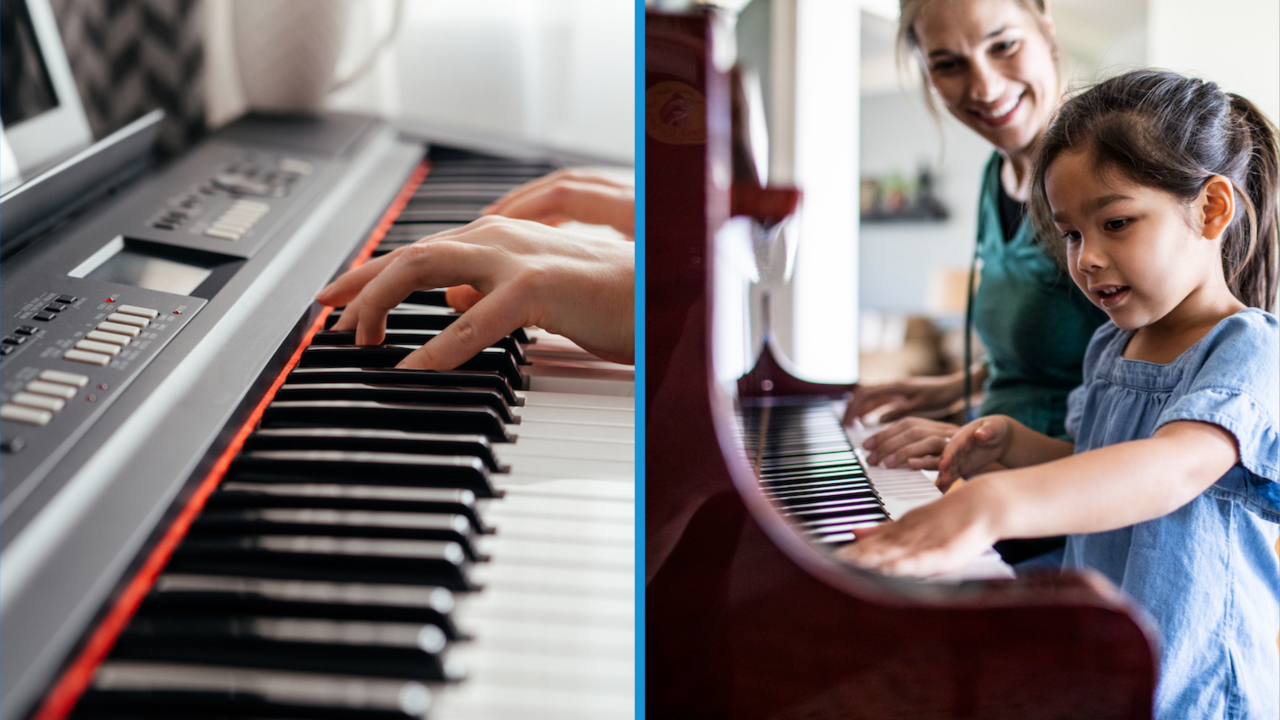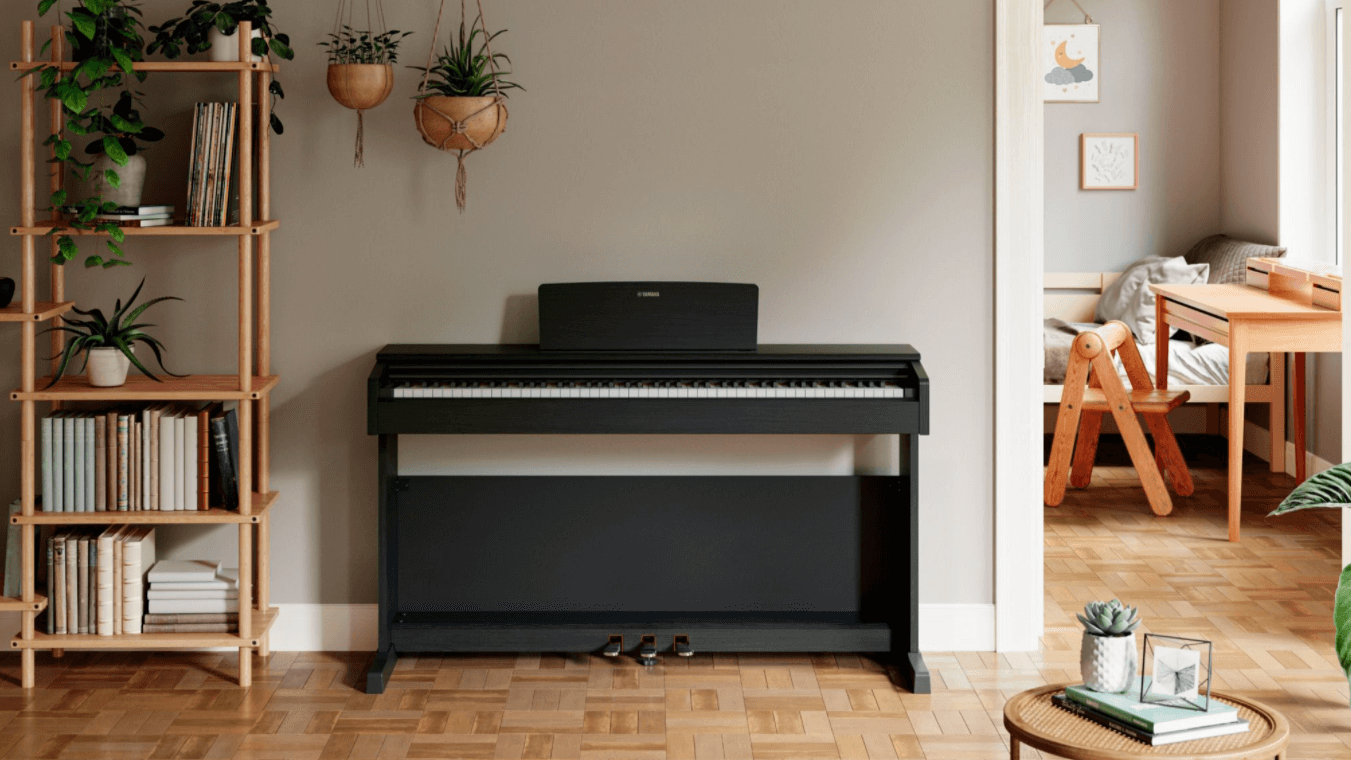Digital piano vs acoustic piano: what’s the difference?
Both beginners and proficient pianists aspire to play on ‘proper’ acoustic pianos, but can its modern digital counterpart prove even better than the real thing? Let’s find out…

The pianoforte is one of the greatest inventions of all time. Third only to sliced bread and the electric toaster in my book, in recent decades it’s had the digital piano snapping at its heels to claim joint third place.
If you’re in the market for a new piano, choosing between the two is a frustrating exercise, even for consummate professionals, let alone novices. They’re so different, yet they share so many brilliant attributes. The acoustic piano has some unique advantages that make it an imposing incumbent, yet the modern digital piano can parry with a shedload of impressive features that make it a worthy contender.
To help you make the best buying decision for your musical needs let’s take a deep dive into their strengths and weaknesses and explore the digital piano vs acoustic piano debate. To keep this guide manageable, I’m going to focus on digital pianos rather than synths, workstations and keyboards, but it’s worth remembering that many of these can produce excellent piano sounds too. Big breath everyone, dive…
Digital piano vs acoustic pianos: Sound

Let’s get this out the way first. If you’re just after something that sounds reassuringly piano-like then either will do just fine. If, however, you’re a tone hound looking for the perfect piano sound you’ll quickly discover that some digital pianos can sound pretty insipid.
Digital pianos rely on sampling or modelling to produce piano-like tones, some even use the combination of the two technologies. Both sound engines are capable of producing astonishingly realistic piano tones – including hammer noise and other mechanical sounds – provided countless samples are painstakingly recorded or the modelling is highly detailed.
Yamaha has historically favoured sampling, while Roland has taken the modelled route, but in a blind listening test, most of us would be hard pushed to tell either brand’s high-end digital pianos from the real thing.
Generally speaking, less expensive digital pianos will use fewer samples and/or their modelled sounds will be cruder. They’ll have limited memory and less CPU power to store and process a large sample library or intricate models, which will prevent them from expressing a full piano sound or truly authentic playing experience.
Want all the hottest music and gear news, reviews, deals, features and more, direct to your inbox? Sign up here.
Just as importantly, budget and beginner digital pianos won’t feature the refined, multi-speaker systems found in high-end pianos, resulting in a sound that lacks richness, depth and complexity.
If you’re on a limited budget don’t be put off or offended by this damning assessment of cheaper digital models. There really are some excellent products out there that can be a joy to play. It’s just that they can’t be expected to rival a top-end acoustic.
Sadly, some acoustic pianos can sound very disappointing too. Ever wondered why you’ll never see concert pianists perform with a compact upright piano? Is it just a style thing? Piano snobbery?
Nope. The overriding reason is that grand pianos sound better because they can house longer bass strings, and often more of them too. In a nutshell, a short, thicker string under high tension won’t give you the rich, sonorous bass tone that a thinner, longer string will. What’s more, it will suffer from greater inharmonicity, which means that the overtones it produces when struck can be slightly sharp.
This quality can be much sought after in some percussion instruments but in a piano the resulting tone can sound harsh. A good concert grand piano tone will always trounce a great digital piano but as you work your way down in size, from baby grand to compact upright, it’s not long before a good digital starts to come out on top.
Digital piano vs acoustic pianos: Playability

Grab a cheap keyboard, or an expensive synth for that matter, and they’ll probably be equipped with light, plastic keys that rely on springs to help them return after being pressed. Trust me, these are exactly the sort of un-weighted keyboard actions that your piano teacher wants you to avoid.
Real pianos have extraordinarily complex, precision actions that have been developed over centuries to enable pianists to play fast, repetitive passages in a dynamic fashion. The key action will become progressively heavier as you play from the treble notes to bass notes, and each key will return immediately so that it can be struck again in quick succession.
The individual keys are also long, with much of their length hidden from sight. This enables the pivot point to be positioned further back, allowing more comfortable and expressive playing between the black keys.
The good news is that even most entry-level digital pianos (not keyboards) can be found with 88-key fully-weighted hammer-action keybeds. Of course, the more you spend the better and more realistic these become but it’s worth remembering that there is no standard. Yamaha actions tend to be heavier than both Steinway acoustic and Roland digital offerings, but there’s no right or wrong, just personal preference. The most important quality is responsiveness.
Digital piano vs acoustic pianos: Affordability

Unfortunately, quality acoustic pianos aren’t cheap.
You may be able to pick up an old ‘no-name’ acoustic upright piano from your local charity shop or eBay for next to nothing but that doesn’t mean that you should. It’s quite likely it hasn’t been cared for in decades and is plagued with potentially expensive issues. It’s also possible that it didn’t sound that great even when new.
Yamaha’s U1 is a legendary upright that’s extremely popular with schools, colleges and amateur pianists. It’s relatively tall at 131cm but that height enables it to house bass strings longer than many baby grand pianos. As such, it’s very well regarded for its tone, its bullet-proof build quality and for holding its value. Expect to pay about £13,000 and upwards for a new one or £5,000 or more for a reconditioned 1970’s model.
The slightly smaller U3 is a less imposing lump that’ll save you a few thousand but while it sounds very good it doesn’t share the rich vibrant tones of the U1.
Expect to pay a bit more, in the region of £18,000, for an entry-level upright C. Bechstein and a bit less for an upright Kawai.
Baby Grands from Yamaha and Kawai are available from about £10,000 - £15,000, but just be aware that although they may look cute they may not sound as good as a tall upright. Grand pianos from Yamaha, Steinway, C. Bechstein and Kawai start in the low tens of thousands, but you can pay well over £100,000 for a concert series instrument.
A major appeal of a digital piano is price, though that’s not to say that they’re all cheap. Roland, Casio, Yamaha and Kawai all produce excellent entry level models, such as the Yamaha P-45 and the Roland FP-10, for well under £500. For that kind of investment you’ll get an 88-key weighted, hammer-action keybed and a decent pair of onboard speakers.
Triple your budget and you’ll get better speakers, a more responsive keyboard, an increased number of sounds, improved connectivity, premium quality plastics and more tones. Popular models include Roland’s FP-90X, Yamaha’s P-515 and Kawai’s ES920.
At this price point these pianos are still ‘slabs’ that can be mounted on an X-stand or installed semi-permanently into an optional MDF stand that looks more functional than attractive.
Spend upwards of £1,500 and there are three purchasing paths that you can follow. It’s at this point that digital pianos ditch their slabby looks and start to look more like acoustic pianos. For example, the Yamaha CLP-785 looks almost indistinguishable from a good quality acoustic upright and the Roland GP609 really does look like a baby grand. Which you choose is really just down to aesthetics.
If you’re a gigging pianist you may wish to explore the third route, which is to buy a stage piano. These often look like the less expensive slabs mentioned above but will boast superb tones, a professional quality keybed/action and a robust chassis that’s usually made of metal or tough plastic. They lack speakers but will have balanced outputs for a PA/desk, and a headphone port for practice. The Nord Piano 5 is the model most pros gas for, but Roland, Yamaha, Korg and Dexibell all make superb stage pianos.
Digital piano vs acoustic pianos: Living with a piano

How many acoustic baby grand pianos are bought as statement pieces of furniture? Quite a number I reckon. Picture a large, light room dressed in a smattering of Charles & Ray Eames furniture and popping Lorca fabrics. What better addition than a baby grand to convince your friends that you are intelligent, cultured and artistic?
A plastic slab of digital piano doesn’t quite cut it does it? However, as previously mentioned, some high-end digital pianos really can look every bit as good as their acoustic counterparts while remaining smaller and more manageable. In fact, since most of us typically only have a modest space in which to install a piano I recommend a premium digital piano over a compact acoustic piano any day. It’ll be slightly less expensive and will almost certainly sound superior.
Most pianos, digital and acoustic, are very traditional in appearance, which may not appeal if you or your family prefer more contemporary lines. In that case take a look at Roland’s sleek Kiyola digital piano, which has a stylish solid oak case hand made by contemporary Japanese furniture maker Karimoku.
Because of their cast-iron frames, acoustic pianos can be extraordinarily heavy making them very cumbersome to install or move. If you live on an upper storey you may even have to reinforce the floor.
Digital piano vs acoustic pianos: Maintenance

Install a digital piano and, other than connecting the juice and dusting the case down with a soft cloth every so often, it’ll remain a faithful musical companion that demands no love or attention.
Acoustic pianos on the other hand are high maintenance. Never install one in a room that’s prone to sunlight, heat, cold, damp or wavering humidity and never position an upright against an outside wall or it could suffer condensation damage.
In the unlikely event that you do find a climatically benign place for it to live (Swindon?) it’ll still need tuning at least twice a year and the action will need to be regulated (serviced) every so often. The costs can mount up.
Digital piano vs acoustic pianos: Game-changing tech
The more you spend on a digital piano the more likely it is that it’ll come with a larger library of piano voices, from Japanese, German and US concert grands to honky-tonk uprights and even clavichords and harpsichords. Trust me, after the first month of playing you’ll use fewer than a handful of these but at least you’ll have the choice. With an acoustic you’re limited to just the one sound (which may be excellent).
Bluetooth capability is much more interesting because it opens up a whole new world of online piano tuition and notation apps for smartphones and tablets. All the major digital brands have their own sophisticated apps that are revolutionising the way in which novices learn, and there are plenty of third-party apps available too. Examples include Roland’s Piano App and Yamaha’s Smart Pianist.
Both brands have also developed apps that enable you to tinker with your digital piano’s sound – everything from hammer noise to cabinet resonance.
It’s very rare that you’ll find a digital piano without MIDI capabilities. MIDI enables you to hook up your piano, usually via USB, to your computer and other hardware for additional voices, recording, automation and a host of other audio and production delights. This guide is too brief to go into the, ahem, ins and outs of MIDI but if you’re a novice with an interest in Garageband or Ableton then a MIDI digital piano (or keyboard) will greatly expand your creative horizons.
Digital piano vs acoustic pianos: The hybrid
So, which is better? Acoustic or digital? Well, clearly acoustic is. Hang on, I’ve changed my mind, digital is the future. The truth is that both can be excellent, but neither is perfect.
What if you could have your musical muffin and eat it? Hardly surprisingly, brands that make both acoustic and digital pianos, such as Yamaha and Kawai, have stuffed some of their acoustics with digital tech. Want the rich, authentic sound of an acoustic? You’ve got it? Want to don headphones for unobtrusive practice or use a Bluetooth-connected app? That too. Your options include the amazing Kawai Aures series and beautiful Yamaha AvantGuard series, but neither are cheap.
The best piano is always going to be the one that speaks to you, regardless of whether it’s digital or acoustic, high-end or inexpensive. Just buy the best quality you can sensibly afford and start playing.
When Simon's childhood classical guitar teacher boasted he 'enjoyed a challenge', the poor man had no idea how much he'd underestimated the scale of the task ahead. Despite Simon's lack of talent, the experience did spark a lifelong passion for music. His classical guitar was discarded for an electric, then a room full of electrics before Simon discovered the joys of keys. Against all odds, Simon somehow managed to blag a career as a fashion journalist, but he's now more suitably employed writing for MusicRadar and Guitar World. When not writing or playing, he can be found terrifying himself on his mountain bike.
